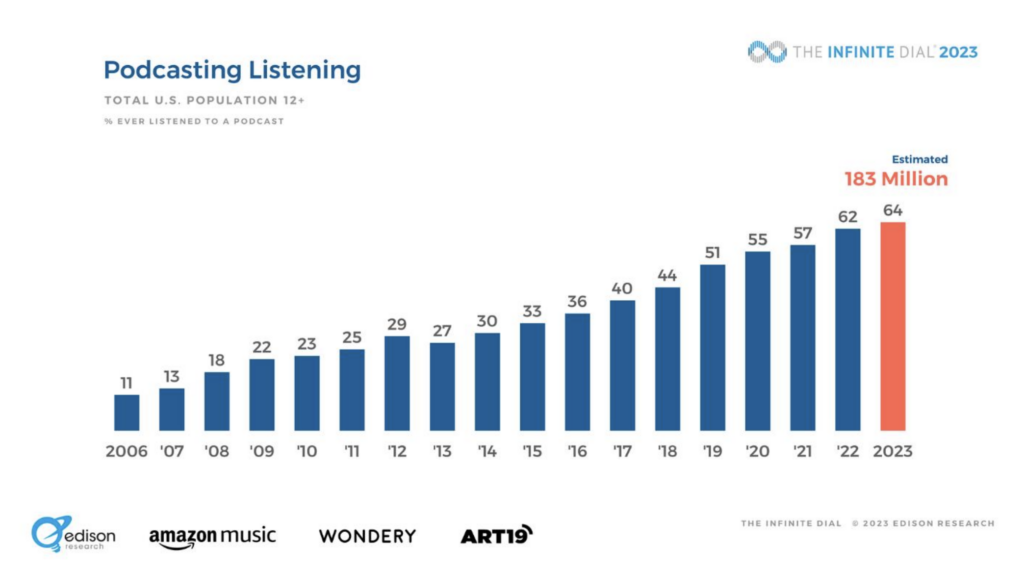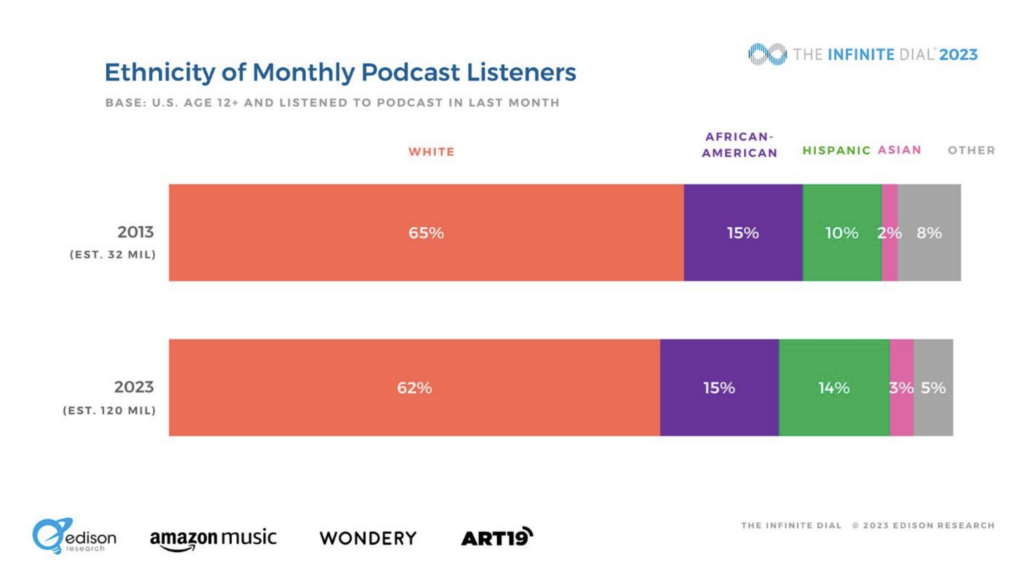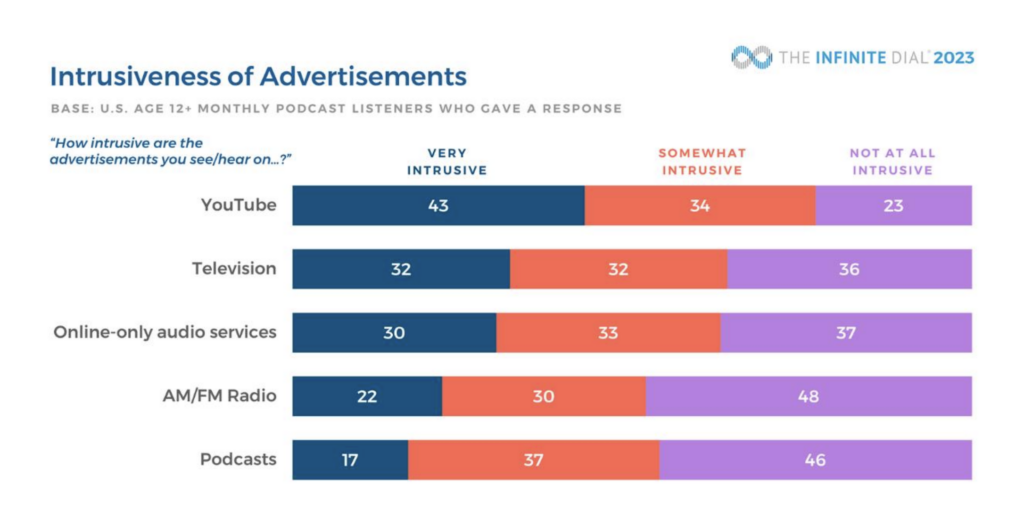With over 5 million shows worldwide and an estimated 237 million listeners in the U.S. alone, it’s safe to say podcasting is popular. 🚀 Through the hard work and commitment of podcasters around the world, the podcasting industry has grown from a niche for hobbyists to an influential, profitable, and essential means of sharing information and stories with others.
While the boom in popularity means there is seemingly an endless supply of amazing shows to discover. However, for showrunners, it can also mean a never-ending requirement to keep up with the latest technology, trends, and data simply to keep listeners interested.
To help its fellow podcasters, the industry has no shortage of people, companies, and resources willing to share their knowledge and expertise—such as Edison Research. Widely known for its accurate and informative market research in a variety of industries, including podcasting, Edison Research releases annual reports that reveal important statistical insights.
Since it’s possible you might not have a ton of time to read through Edison Research’s full article—being a busy podcaster and all—we thought it would be helpful if we summarized Edison Research’s most recent report into 4 Podcasting Facts that can help your podcast.
Before we begin, just like having a well-balanced diet, it’s important to remember growing and refining your podcasting skills doesn’t end here—this is merely one article out of many you’ll collect in your “podcasting toolbelt”. We encourage you to do further research about the industry so it might lead to tangible results for your podcast.
You can find Edison Research’s full report here if you’d like to read it in full.
So, here they are…4 things you need to know about podcasting in 2023.
1. Podcasting is Popular
Does it feel like everyone knows of, listens to, or has a podcast nowadays? (Of course, we said it at the beginning! 😉)
That’s because 83% of Americans 12 or older have heard of the term “podcasting”. Just think about that for a moment. 83% of Americans in this study reported they’ve at least heard of podcasting.
Wonderful! People know what podcasts are—however, the popularity goes deeper than recognition of the word. During the 2022-23 research window, data showed U.S. listenership hit an all-time high.
- 64% of the population listened to a podcast at some point.
- with 42% of the population listening to a podcast in the last month.
- and 31% listened to a podcast during the last week, at the time of polling.
Sure—the podcasting industry experienced a bump in popularity during the COVID-19 pandemic. However, this industry-wide growth started well before 2020. Below is the estimated yearly percentage of listeners in the U.S., dating back to 2006.

In other words, podcasts have been steadily growing in popularity for close to two decades! If the trend lines how at the current pace, by 2026 nearly 70% of the U.S. population will have joined the podcast-listening community. 🤯
How This Helps:
Existing podcasters:
This means there is a continuously increasing demand for podcasts. 183 million potential listeners are waiting to discover your show. When you release new episodes, you’re not only providing valuable content to your existing audience but also to the potential listener who hasn’t discovered you yet — ultimately growing the industry’s awareness and popularity. As the saying goes, “A rising tide lifts all boats.”
Listeners continue to consume episodes because podcasters continue to release new episodes—day after day. So, keep up the good work!
Potential podcasters:
This is your official invitation to start a podcast if you’ve been on the fence about it. Previous studies have shown that the average U.S. podcast consumer subscribes to a minimum of 6 different shows. Out of an estimated 183 million listeners, this means there is undoubtedly an audience who will pick YOUR podcast as one of the six shows to listen to.
Don’t believe us? Here’s a quick episode from our co-founder, Pat Flynn, about why everyone should have a podcast.
2. There’s Growing Diversity
Your audience knows who you are — Do you know who they are? 🤔 By the numbers, here’s what research tells us about who is listening to podcasts each month.
- 45% of Black Americans listen to a podcast each month.
- 34% of Hispanic & Latino Americans listen to a podcast each month.
- Black and Latino Americans comprise 25% of the monthly U.S. listeners.
- 46% of U.S. listeners are women.

Edison Research goes further in-depth, detailing the percentages of listenership compared to income and employment statuses, if you’re interested in learning these details, you can view their full report here.
How This Helps:
Existing podcasters:
Knowing your audience is paramount. However, after looking at this data, how much do you know about your audience other than they listen to your show?
In other words, your audience is more diverse than you probably think—even if your genre is niche. Each listener has multiple facets to their personality and personhood. To ensure you deliver content they want to listen to, we recommend you get to know your audience by asking for feedback, sending email polls, or hosting live chats with listeners.
Not sure of the best way to offer an email poll? The Fusebox player can display a custom CTA, taking your listeners to any URL you’d like—such as a Survey Monkey or Typeform landing page. It’s a perfect (and passive way) to get to know your audience on their own time.
Potential podcasters:
Since you’ll be starting from scratch, the only audience demographics you’ll have to rely on will be broad, industry-wide reports, like Edison Research’s study. As such, you can start by simply asking your listeners to complete some basic surveys and feedback questionnaires via an email list.
If you don’t have an audience yet, let alone an email list—that’s okay.
We recommend finishing each episode with a request for audience feedback. It can be as simple as saying “Make sure to send us your thoughts and comments to myshowemail@email.com”. As your responses grow, so will the size of your email list.
3. Listeners Are Listening
As we mentioned at the beginning, statistics show that podcast listenership has consistently increased, year-over-year, since 2006. But what about how people listen to podcasts? Research shows that podcast listeners are…
- Listening for longer,
- Listening more frequently,
- and listening to more shows.
The average weekly time spent listening to podcasts has DOUBLED since 2015, with reports showing an average of 9 hours per week.
Out of the monthly listeners, 75% report they are also weekly listeners—with nearly 50% reporting they spend 5 or more hours listening per week! 🤯

Finally, nearly 60% of the listeners consume 4 or more episodes each week — with the average number of subscribed-to or followed shows averaging around 6 per individual.
How This Helps:
Existing podcasters:
If your schedule allows, try releasing weekly episodes that consistently run the same length. By releasing weekly episodes, you increase the likelihood of staying part of your audience’s weekly routine—with an increased chance they will also subscribe to your show.
Keeping the length of your episodes consistent will help train your audience to know how much time out of their weekly listening “allotment” your podcast will take. For example.
- Releasing a single, three-hour episode means you occupy 33% of a listener’s weekly capacity. Increasing the likelihood they may never finish your episode or skip it altogether.
- Releasing three, one-hour episodes (spread over three weeks) occupies approximately 12% of a listener’s weekly capacity. This means your show can more easily become part of a listener’s weekly rhythm while also providing you the same amount of total podcasting hours.
Potential podcasters:
This is the perfect opportunity to play around with the length of your episodes. Start by researching other podcasts in your genre and getting a sense of the average length and content presentation. Don’t be afraid to write down things you enjoyed and things you’d do differently.
It’s still recommended you release episodes on a regular schedule. However, if you’re just getting started, one a week might be a lot to manage. Start with bi-weekly episodes until you get proficient at planning, recording, and producing episodes.
4. People Don’t Mind Ads
Ads are not anything new. From magazines, television, and YouTube videos—inserted advertisements are an expected part of the commerce and monetization of such platforms. Podcasts are no exception to this fact.
However, there’s something different about podcast ads when compared to other platforms —and it mostly has to do with…
- The perceived level of intrusiveness.
- The applicability of podcast ads vs other platforms.
Perceived Intrusiveness
Podcast ads have a distinct advantage compared to almost every other medium. That’s because podcast ads don’t always feel like ads. Many times, podcast hosts will seamlessly transition from their episode’s content into reading an ad, and then back again. As a listener, you might not even notice it at all. By the numbers, here’s a look at how podcast listeners rank the intrusiveness of ads across different platforms.

When comparing the “very intrusive” category, weekly podcast listeners found:
- Ads on YouTube were 2.5 times more intrusive.
- Ads on Television were almost 2 times more intrusive.
While the large jump in perceived intrusiveness can be partially attributed to the seamlessness in presentation, it can equally be attributed to this second point…
Podcast Ads Are More Applicable
Unless the podcaster is part of a network or media company, the host is given full control over the companies with which they work. This freedom gives hosts the ability to find companies that…
- More closely align with their brand and values.
- Offer products that match their audience’s interests and demographics.
- Self-record the ad audio (aka “Host-Read Ads”).
How This Helps:
Existing podcasters:
In short — ads on podcasts are more tolerable AND more relatable — giving the host the ability to build a deeper (and more genuine) rapport with their audience.
While we don’t recommend booking as many ad spots as you can, it’s reassuring to know that podcast audiences don’t mind hearing an ad in your episodes, especially if it’s something they may like.
Potential podcasters:
It’s good to know that inserting podcast ads on your show doesn’t come with the icky feeling some people get when they have to sell a product to someone.
Instead, it can be seen as an opportunity to recommend products and services to your audience they might actually find to be helpful in their lives.
Wrap-Up
Undoubtedly, the podcasting industry is here to stay. With the growth in recognition and listenership, podcasts are quickly (and steadily) becoming part of the way many consume digital content.
As a listener, podcasts offer variety and individuality—with each host bringing a unique quality and twist to their show. As a podcaster, growth means opportunity — an opportunity for listeners to discover your show — an opportunity to reach beyond a single audience and strive toward aiming bigger.
Regardless of whether you’ve started your podcast or not, we truly believe there’s no better time than the present to start sharing your voice.
As we mentioned earlier, podcasting is still very much a community. Should you have any questions or thoughts — you can reach out anytime at help@fusebox.fm.
